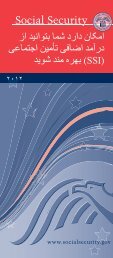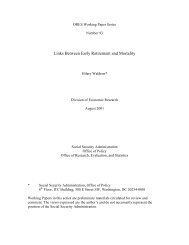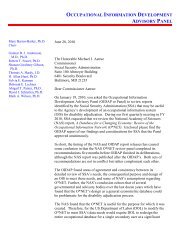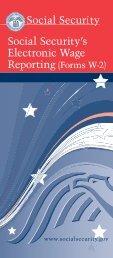Download entire publication - Social Security
Download entire publication - Social Security
Download entire publication - Social Security
Create successful ePaper yourself
Turn your PDF publications into a flip-book with our unique Google optimized e-Paper software.
self-employment information for the worker duringthat year. If wages were less than the OASDI taxablemaximum, then the employee was required to payOASDI taxes on any self-employment income up tothe OASDI taxable maximum. Therefore, SSA collectedpartial data reflecting self-employment incomeup to the OASDI taxable maximum. Starting in 1991,additional self-employment earnings—up to the Medicaretaxable maximum—were added to the MEF. Withthe elimination of the Medicare taxable maximumin 1994, the MEF began including all reported selfemploymentincome.Deferred CompensationAnother change to the MEF resulted from the proliferationof deferred compensation. Deferred compensationis an arrangement in which a portion of anemployee’s wages are paid out in a year after that inwhich they are actually earned. This usually occurswith certain retirement plans such as 401(k)sand is usually done to defer the payment of incometaxes. In 1984, earnings reports began to includeelective deferrals for those workers with wages belowthe taxable maximum, although deferrals were notexplicitly identified and the information was incomplete(Pattison and Waldron 2008). 15 As previouslydiscussed, the <strong>Social</strong> <strong>Security</strong> taxable maximum isindexed to the growth rate in the national averagewage. In 1989, P.L. 101-239 changed the calculationof the national average wage to include certain typesof deferred-compensation plans for years after 1991. 16Since 1990, SSA has collected additional informationon the aggregate value of workers’ deferred compensationfrom Form W-2 to include in the national averagewage calculation, which is used to calculate the annualtaxable maximum (and other wage-indexed amountsfor the OASDI program). 17 Starting in 2004, SSAbegan to capture information on the specific type ofdeferred compensation (for example, a 401(k), 403(b),or 457(b) pension plan) and wages that were put intoHealth Savings Accounts (HSAs). 18 This more detaileddeferred compensation and HSA information is nowcontained in the MEF.Relevant Time PeriodsAmendments to the <strong>Social</strong> <strong>Security</strong> Act have not onlyincreased the number and types of workers coveredby the program, they have also necessitated changingthe types of earnings information that are collectedby SSA. Other laws passed by Congress and technologicalchanges have also shaped the MEF data. Thedevelopment of the MEF can be divided into threesignificant time periods: 1937–1950, 1951–1977, and1978 to date (see Chart 3).1937–1950. Initially, taxable wage reports for individualworkers were sent by the IRS’ forerunner, theBureau of Internal Revenue, to SSB and, later, to SSA.Reports were sent on a semiannual basis in 1937, andon a quarterly basis thereafter, for employers withworkers covered by the program. These wages werereported for each worker up to the taxable maximum(Fay and Wasserman 1938). This information, sentto SSB on the Employer Report Schedule A (Form941), 19 was then manually transferred to punch cards.The punch card data were entered onto the ledgeraccounts of individual wage earners and checkedagainst employer totals for accuracy (Corson 1938). 20Recordkeeping of earnings during this period involvedthe use of collating, sorting, card punching, accounting,and posting machines (Cronin 1985). Noncoveredearnings were not reported to SSA in the early yearsof <strong>Social</strong> <strong>Security</strong> because they were not needed forprogram purposes. Owing to limited storage capacityand the prohibitive costs of converting early earningsdata to an electronic format, data for 1937 to 1950are only available as two aggregate numbers for eachworker: 21 total <strong>Social</strong> <strong>Security</strong> taxable earnings for1937–1950 and total QCs for 1947–1950.When needed, there are various procedures forestablishing a count of QCs for this 14-year period.First, SSA counts QCs from 1951 forward. If thoseare insufficient to establish insured status, the QCsfrom 1947 to 1950 are considered, as well. If these donot provide enough quarters to be insured, then SSAallocates one QC for each $400 of covered earningsfrom 1937 to 1950. 22 If the individual is still notinsured, SSA conducts a detailed earnings search ofthe microfilm records to determine the exact numberof QCs. The individual is credited with a QC for anyquarter in which he or she had $50 or more in coveredearnings during this period; if he or she earned thetaxable maximum in a year, four QCs (the most thatcan be earned each year) are credited.1951–1977. The <strong>Social</strong> <strong>Security</strong> Amendments of 1950changed the benefit calculation to increase monthlybenefits payable (Cohen and Myers 1950). The newbenefit calculation “put greater reliance on the useof individual yearly earnings totals” starting in 1951(Cronin 1985). In addition, SSA began converting filesto microfilm in the late 1940s and early 1950s andthe installation of the first computer in 1956 greatlyincreased the use of magnetic tape at the agency34 <strong>Social</strong> <strong>Security</strong> Bulletin • Vol. 69 • No. 3 • 2009








